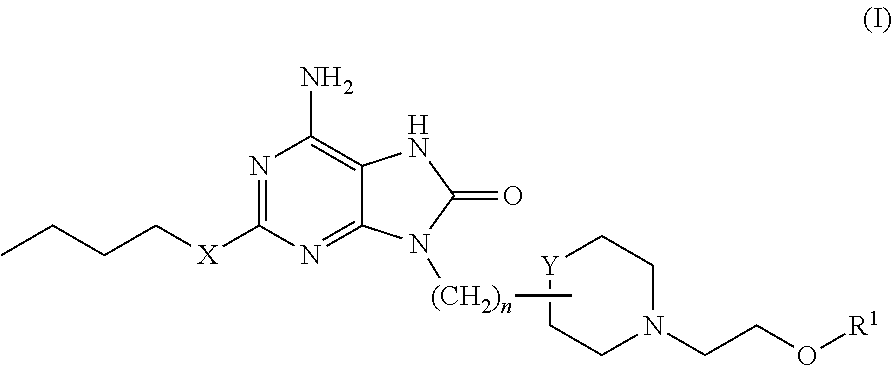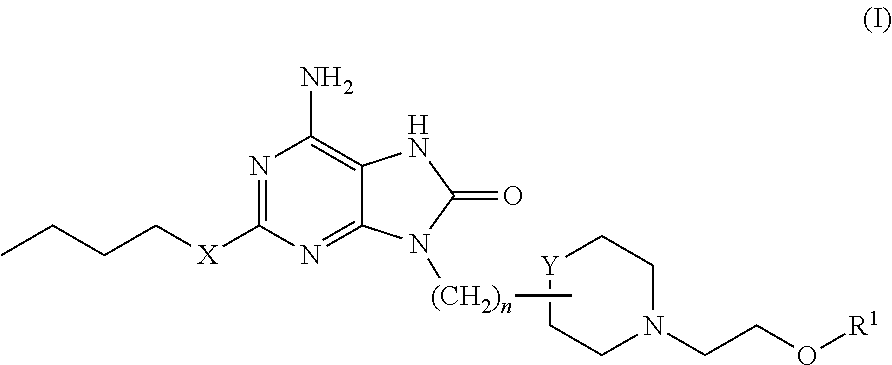Purine derivatives and their pharmaceutical uses
a technology of purine derivatives and derivatives, applied in the direction of antibody medical ingredients, drug compositions, immunological disorders, etc., can solve the problems of disease modification, failure to show sustained viral response, and inability to control viral load
- Summary
- Abstract
- Description
- Claims
- Application Information
AI Technical Summary
Benefits of technology
Problems solved by technology
Method used
Image
Examples
preparation 1
[0212]2,6-Dichloro-9-(tetrahydro-2H-pyran-2-yl)-9H-purine (for example, as prepared for Intermediate 1) (36.9 g) was heated with 2M ammonia in isopropanol (250 mL) at 50° C. for 5 hours. After standing at ambient temperature overnight, a further quantity of 2M ammonia in isopropanol (100 mL) was added to break up the resultant cake and the reaction mixture was heated for a further 9 hours until the reaction was complete. To the reaction mixture was added water (70 mL) and the yellow solid filtered off. The solid was washed with isopropyl alcohol:water (5:1 (v / v), 60 mL) and then air-dried under suction to give a first crop. The filtrate was re-filtered after standing overnight to isolate precipitate and both solids were dried in vacuo. The first crop was pure with the second crop material showing a very minor impurity (isolated broad signal 3.5 ppm not seen in first crop) but was otherwise identical. Solid first crop (28.4 g), solid second crop (3.42 g).
[0213]1H NMR (CDCl3): 8.01 (1...
preparation 2
[0214]To a solution of 2,6-dichloropurine (commercially available, for example, from Aldrich) (25 g) in dry ethyl acetate (200 mL) was added p-toluenesulfonic acid monohydrate (235 mg). The reaction was heated to 50° C. and 3,4-dihydro-2H-pyran (commercially available, for example, from Aldrich) (18.1 mL) was added in one go. The reaction was allowed to stir at 50° C. for 1 hour and the solvent was removed under reduced pressure. This afforded a yellow solid. A suspension of this solid (˜36 g) in 2.0M ammonia in isopropanol (460 mL) was heated under nitrogen at 60° C. for 4 hours with an attached condenser. The reaction was poured into water (50 mL) and left to cool overnight. The precipitate was filtered and dried on a rotary evaporator (60° C.) for 30 minutes to afford the title compound as an off-white solid, 31 g (93%, 2 steps).
[0215]MS calculated for (C10H12ClN5O)+=254, 256
[0216]MS found (electrospray): (M)+=254, 256 (3:1)
[0217]1H NMR ((CD3)2SO): δ 8.43 (1H, s), 7.82 (2H, s), 5...
example 1
6-Amino-2-(butyloxy)-9-[3-[1-(2-hydroxyethyl)-2-piperidinyl]propyl]-7,9-dihydro-8H-purin-8-one
[0357]
[0358]2-(Butyloxy)-8-(methyloxy)-9-[3-(2-piperidinyl)propyl]-9H-purin-6-amine (for example, as prepared for Intermediate 12) (0.036 g, 0.10 mmol) in DMF (0.5 mL) was added to 2-bromoethanol (commercially available, for example, from Aldrich) (0.0085 mL, 0.12 mmol) (dispensed as 0.12 mL of a stock solution of 1 mmol in acetonitrile (1 mL)). DIPEA (0.040 mL, 0.23 mmol) was added and the reaction mixture heated at 50° C. for 18 hours. An additional aliquot of the 2-bromoethanol solution (0.080 mL, 0.08 mmol) and DIPEA (0.040 mL, 0.23 mmol) were added and heating continued for a further 18 hours. The reaction mixture was diluted with DMSO:MeOH (0.2 mL) and the resultant solution purified by MDAP (Method A). Appropriate fractions were combined and evaporated in vacuo. The residue was dissolved in 4M HCl in dioxane (0.2 mL) and allowed to stand at room temperature for 4 hours. The solvent w...
PUM
| Property | Measurement | Unit |
|---|---|---|
| weight | aaaaa | aaaaa |
| temperature | aaaaa | aaaaa |
| temperature | aaaaa | aaaaa |
Abstract
Description
Claims
Application Information
 Login to View More
Login to View More - R&D
- Intellectual Property
- Life Sciences
- Materials
- Tech Scout
- Unparalleled Data Quality
- Higher Quality Content
- 60% Fewer Hallucinations
Browse by: Latest US Patents, China's latest patents, Technical Efficacy Thesaurus, Application Domain, Technology Topic, Popular Technical Reports.
© 2025 PatSnap. All rights reserved.Legal|Privacy policy|Modern Slavery Act Transparency Statement|Sitemap|About US| Contact US: help@patsnap.com



